Archive for the ‘Urbanization’ Category
Business Findings of the Kumbh Mela Team (comments for TOI)
(I drafted these comments in response to a query from Times of India directed through Meena).
Questions
1) Purpose of the “Mapping the Kumbh Mela”- South Asia Institute
2) Could you elaborate on the focus of the project? – Faculty member at the South Asia Institute
3) Experience at the Kumbh Mela – Any student visitor
4) Thoughts on the temporary settlement built for the purpose of the Kumbh Mela
5) Findings of the business at Kumbh Mela team – A researcher of the business team (JOHN)
6) Additionally, would it be possible for any one of the student researchers to write a piece of about 350 words on his/ her experiences and findings at the Kumbh Mela? This would be separate story to go in our student speak column.
John’s answers (we will see what gets published):
A: The Harvard Business School component focused on two aspects of the successful organization and operation of the Kumbh Mela: one, lessons from administration and leadership, and two: lessons from infrastructure design, delivery, and finance. Read the rest of this entry »
Draft comments about learning – Wall Street Journal
(I drafted these comments in response to a query from Wall St. Journal Asia – John)
Q: I’m writing about the Kumbh Mela for the Wall Street Journal and I wondered if I could ask you about your visit there? I read your interesting article in Forbes Magazine about your experience and was very taken by your description of the Mela as a pop-up megacity.
Q: Are there other examples of pop-up megacities in the world? If so how does this compare?
Q: I was also really interested in your comments that future cities will have to learn from the Kumbh Mela. Please could you elaborate on why?
Q: What do you think India can learn from the organization of the Kumbh?
Q&A for “International Business” magazine
Questions from reporter (via Meena):
Q: The HBS team has just spent time at a completely unique event. Understanding that your research is not complete, can you share any initial impressions about the research experience, especially given all of the prep that went into it?
Q: What do you expect the HBS case study to contribute (again, realizing that your results are not out) to discussions on business or management, especially given that there is no other event in the world like the KM?
Q: During the visit to the KM, were there any particular “teachable moments” that stood out to you? Any anecdotes (that you’re comfortable sharing at this point) that illustrate some bigger lesson?
Answers:
Q: The HBS team has just spent time at a completely unique event. Understanding that your research is not complete, can you share any initial impressions about the research experience, especially given all of the prep that went into it?
A: Our team included faculty and students from four schools at Harvard, including Divinity, Public Health, Urban Planning, and Harvard Business School (HBS). It’s unusual in academia to have four disciplines doing research together. At the Kumbh Mela, it’s quite obvious that religion, well-being, cities, and finance all combine to lead to a successful experience for tens of millions of pilgrims. The scale of the Kumbh Mela, the explosion of sensory inputs from sound to sight to touch, and the clear spirituality of the pilgrims made it that much more real, that much direct, and that much more intense for all of us. It’s a lot different than, say, a finance professor working alone and doing academic finance work by creating panelized regression on a stock market dataset. Read the rest of this entry »
Why a Harvard Finance Instructor Went to the Kumbh Mela
by John Macomber
…I’m in a winter coat and hat in the January pre-dawn cold and dark, standing on sandbags on a riverbank in the middle of Uttar Pradesh, India. Pilgrims and the faithful and the respectful come to the river this morning by the hundreds, clad in the minimum, praying and splashing and releasing marigold wreaths and rafts of small oil lamps into the river. This is not like any field research I’ve done before.
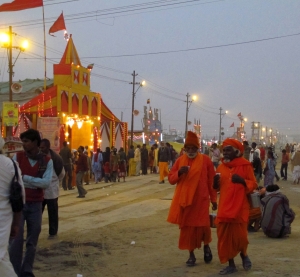
Two pilgrims pass an Akhara façade in the evening on Triveni Marg, a temporary boulevard. (Photo credit: John Macomber)
Thirty-five Harvard colleagues and I are at the Kumbh Mela in Allahabad, India, a mass pilgrimage in which tens of millions of Hindus gather to bathe at the confluence of the sacred Ganga (Ganges) River, the Yamuna River, and the mythical underground Saraswathi. Legend says that on his return to the Himalaya, Vishnu flew over this spot and dropped sacred nectar from a pitcher – a kumbh.
Six months ago this land was under 30 feet of water. Three weeks from now this will become the largest city on earth, the largest single-purpose gathering of humanity in history. Every 12 years, when the moon and stars are aligned, this becomes the most auspicious spot in Hinduism, and there is a six-week-long festival, or mela, for the millions of pilgrims. The Maha Kumbh Mela is happening right now. It’s expected to draw close to 200 million people over almost eight weeks, and as many as 30 million in a single day. The Harvard team is here to learn about why and how.
Our team is led by Prof. Diana Eck of the Harvard Divinity School. She is a world expert on pilgrimages and the author of definitive books about the rivers of India. Prof. Rahul Mehrotra, chair of the department of urban planning and design at the Harvard Design School, has a team on site mapping and photographing the city that has sprung up here. Prof. Greg Greenough of the Harvard School of Public Health is directing researchers interested in everything from the pH of the Ganga to the quality and quantity of toilets to the structure of the medical response teams in place; after all, from time immemorial pilgrimages have been perfect places to transfer and share not only information, but disease as well. From Harvard Business School, I am here to discover what the Khumb Mela can teach me about real estate, urbanization, sustainability, and infrastructure. We are all here to witness how devotion, design, health, and finance come together…
Read more on Forbes Working Knowledge
Read more on HBS Working Knowledge
On Pilgrims and Refugees: A Comparative Reflection Susan Holman, Senior Writer, Harvard Global Health Institute
How does the Kumbh Mela compare with a refugee camp? I found myself reflecting on this question in our research project on the Kumbh Mela during a bumpy ride on Monday through “Sector 7,” the northmost tract of the fairgrounds. I am participating in the Harvard Kumbh project as part of the Harvard Global Health Institute (HGHI), a university-wide institute under the Office of the President and Provost. As a co-sponsor for the Harvard Kumbh project, HGHI provided funding for faculty and students from the School of Public Health, the Divinity School, and the College; course support for the fall 2012 Kumbh Mela Workshop co-directed by Professors Mehrotra and Eck; a resource portal on its website as part of its focus on urbanization and its effects on global health; and ongoing collaborative development of educational public goods.
The Kumbh’s Sector 7 is a vast flatland, where wandering pilgrims, workers, and all-terrain vehicles wind their way across the mud-and-metal-plate road and between a medley of corrugated metal and temporary frame huts and tents. It is miles away from the flashy, carnivalesque akharas; even the holy river is barely a glimpse in the distance. In such a setting, what can the Kumbh Mela teach about temporal urbanism that might help improve responses to humanitarian emergencies and refugee settlements?
After four days at the Kumbh, experiencing this amazing event very much as a subjective encounter, it strikes me that the Kumbh Mela radiates with at least three elements that seem characteristically very different from conditions in urban emergencies, worth considering in developing discussion on this unique liminal space:
1) “Mood.” This was undergraduate Isaac Dayno’s instant response to my wondering aloud about these differences as we bumped along in the van. There is an atmosphere of energy. Everyone is excited to be here, to use this temporary opportunity for good, whether spiritual or material. As the land waits, and construction continues for the millions still to come for the major bathing days, there’s a buzz in the air. This is true even though people are living in conditions that often look to me very much indeed like those of refugees. And yet their focus is religion. It is religious meaning that is at the heart of this mood, the very pulse of this temporal urbanism.
2) Committed governance. The whole shebang is funded and supported by the local and state government. Public commitment to governance is everywhere: police sit prominently at all the road junctions. Tractor-drawn water trucks keep the dust down. Corrugated tin latrines are marked by prominent signs every few hundred yards. A daily truck ploughs through the roads emitting a cloud of insecticide in its wake. I haven’t seen a mosquito yet (and yesterday actually watched a fly die). Workers in dun-colored garb and official caps trudge along carrying round wicker baskets that, dropped at intervals, mark the road with mandala-shaped impressions of a white antiseptic powder. Of course this process is not perfect. But there is high motivation for a public show.
3) Profit. Unlike urban crises, where refugees come as “losers,” pilgrims come to the Kumbh by choice. The religious, government, and medical officials come because it is expected, and though they are on call 24/7, both the mood and governance processes generate a confidence in a happy outcome to the event. Everyone comes expecting to receive something profitable—be it holy water, release from reincarnation, a blessing, or market profit. The patronage and gift exchange is liberal—and consciously time-limited. Even the most devout pilgrims who arrive on foot, with nothing more than the clothes on their back, will go home again. Even when the river rises once again, closing over the grounds with its sacred flow for another year, everyone knows the festival is not over: it merely waits for next time.
Kumbh Mela January 20, Diana Eck
All night, the waves of chants rolling from the tents and pavilions of the Kumbh Mela are a pillow of sound for our sleep. By 5:00 a.m., the sounds become louder and more insistent punctuated by the occasional conch blasts, announcing a new day. Some of our research groups are out early, leaving by 5:30 to visit the sangam for the early morning activities or the vegetable market to track the food routes into the vast camp. For us, the day began after nine, when our research group went to sector 9, almost the “suburbs” of the Kumbh City, where the camps are more spacious and where some of the construction is still very much in process. The crews that are world-experts in the bamboo and rope construction method were out lashing up gateways and the walls of cottages and audience halls. Several of the most popular gurus, like Pilot Baba, have their camps in this sector.
Our destination was the camp of the head of the Juna Akhara, Swami Avdeshanand Giri Ji, the Mahamandaleshvara of Juna Akhara. We arrived at just the same time the gates opened for what seemed like thousands of sannyasis who surged into the spacious compound like a great pale orange wave and then fell into an orderly single file line that moved steadily toward the hall where they each were to be fed with sweets, namkin, and tea. As they entered the hall, each stopped at a table set up in the courtyard to receive a 20 rupee bill as dakshina, the payment offered by Avdeshanand Ji for accepting his hospitality. More later on our tour of this spacious camp and our visit with Avdeshanand Ji. Diana Eck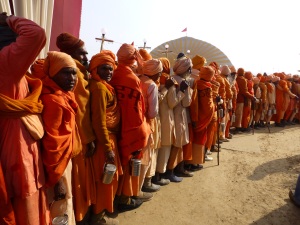
Kumbh Mela, January 19, Diana Eck
Kumbh Mela, January 19
Today we spent time in two different kinds of camps. In the morning, we went into the sector nearest the sangam where the ascetic renunciants live in their akharas. Near the main gate of the largest, the Juna Akhara, we met with Rampuri who has been present at Kumbh Mela for the past 42 years. Born in California and a long-time initiate in the Juna Akhara, Rampuri has both the experience and perspective to be a bridge to the world of our students. We sat for most of the morning around his dhuni, his altar-fireplace, and listen to him respond to our questions about the meaning of the Kumbh Mela and the life of the Juna Akhara. Rahul’s group came late in the morning and worked on the quadrant layout of the whole of the Juna Akhara.
In the afternoon, we went across a long pontoon bridge to the camp of Swami Chidanand Sarasvati, who was launching an effort of the Ganga Action Parivar at the Kumbh. The Governor of the Uttaranchal was there, known widely as the Green Governor, as were mayors of several of the cities along the Ganga, including the mayor of Allahabad. It was a strong indication that cleaning the Ganga will involve not just spiritual commitment, but the leadership of those who deal with urban infrastructure along the River. We had a discussion afterwards with Sadhvi Bhagavati Sarasvati, a Stanford graduate who has been part of the ashram for some sixteen years, and were received at the end of our visit by Swami Chidanand-ji himself. Students keen on understanding the Green Kumbh movement are eager to come back, which we will. 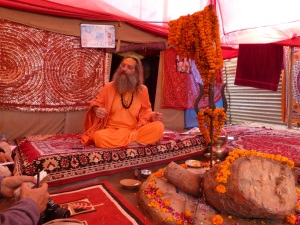
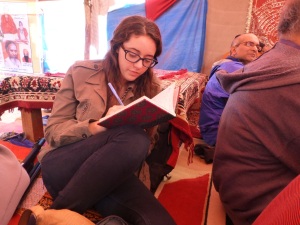
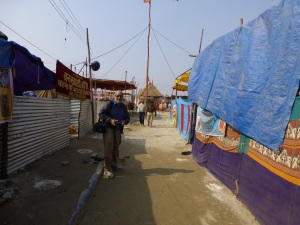
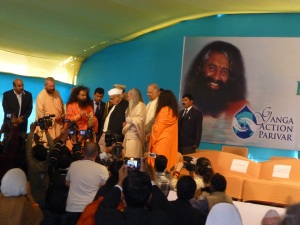
The end-of-the day reports from the four research teams out in Kumbh Nagar today were fascinating.

